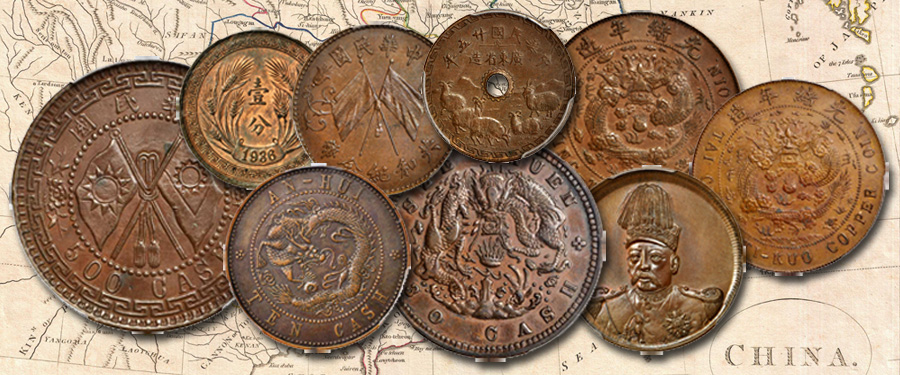
In the study of
numismatics one can learn a lifetime’s worth of knowledge in a relatively short
period of time, given the chance and right circumstances. It is not every day
that one gets the opportunity to catalog an extensive collection of any sort. The
opportunities are even fewer to catalog a cabinet of the magnitude and
specialization assembled over decades by Q. David Bowers/R.B. White. Included
in this monumental offering by Stack’s Bowers and Ponterio are many highly sought
after rarities and very interesting pieces that have been off the open market
for 50 years or longer. It was a pleasure and a great honor to catalog such a
collection, one that encompasses so much and yet is very focused.
在研究錢幣的過程中,如若時機和環境得宜,短時間內習得的知識會令你終生受益。對任何品類錢幣的集藏來說,藏品想要達到豐富全面,都實屬不易,為這樣一個集藏撰寫圖錄的機會更是鳳毛麟角。而筆者得以為Q. David Bowers / R.B. White 歷時數十年徵得的專題集藏撰寫圖錄,著實倍感榮幸。本場拍賣是Stack’s Bowers and Ponterio的又一里程碑,當中呈現的許多拍品均是藏家爭購的珍罕版別,還有不少趣味品種五十多年來從未公開面市。這一集藏可謂是既包羅萬象,又類別分明。
Coins
produced from copper and its alloys have a deeply rooted history in Chinese
numismatics. The Spring and Autumn period (ca. 770-476 B.C.E) saw the introduction
of the first metal “coins,” these in the shape of knives and spades. In later periods the more
familiar square-hole Cash were produced. In the late 19th century, the
Kwangtung mint, the first mechanized mint of China, was set up by the Heatons
of Birmingham, England. It became the
largest mint in the world, surpassing facilities in London, Vienna, Berlin,
Osaka, and Philadelphia. The first issues from the Kwangtung mint had far
reaching implications, as they would set the standard design for China’s new
machine-struck coinage. In time, many modern mints were set up all over China,
resulting in a wide variety of styles and characteristics specific to individual
regions. Though nearly all were based on the first issues from the Kwangtung
mint, each has its own distinctions.
在中國,銅及銅合金貨幣的歷史源遠流長。早在春秋時期(公元前770-476年),金屬錢幣便已出現,即刀幣和布幣等。後來又鑄造了大家較為熟知的圓形方孔錢。十九世紀晚期,中國的第一間機製幣鑄幣廠在廣東由英國伯明翰喜敦鑄幣廠(Heatons Mint)設立,鑄幣設備規模之大為世界之最,超越倫敦、維也納、柏林、大阪及費城。廣東鑄幣廠出產的第一批錢幣後成為全中國機製幣的模板,影響深遠。此後,機製幣鑄幣厰在中國各省遍地開花,雖然其他省份所產銅幣均以第一版廣東銅幣為樣本,但它們風格各異,帶有濃郁的本土氣息。
The amount of material
that was acquired by Q. David Bowers / R.B. White and then painstakingly
attributed could be overwhelming if taken in all at once. To help better
understand the depth and breadth of this astonishing collection, we will
describe selections from the late-Qing to the early Republic to highlight the numismatic
treasures it contains.
Q. David Bowers / R.B. White集藏,是兩位資深藏家窮畢生心血收集補充的成果,洋洋大觀,須細細學習,不可急於求成。以下特摘錄部分晚清至民國時期精品,幫助讀者了解該集藏的深度與廣度。
We start with this Anhwei
“Flying Dragon” 10 Cash undated (ca. 1902-06) with the English spelling of the
province name blundered, reading “AN-HUI”. It is a type and variety that rarely
appears on today’s market.
安徽“飛龍”十文(ca. 1902-06),英文省名AN-HUI,現今市面罕見。
Next is a
Kiangsu-Chingkiang Pattern 20 cash
(CD 1906) that
is one of only two known and the only example in private hands. The other is in
the Shanghai museum. Since the Chingkiang mint was initially set up to produce
10 cash size coins they needed additional equipment to make this denomination.
After a small number were struck it was discovered that this new minting
equipment lacked sufficient power to produce these larger size copper coins.
They were never put into full production and the equipment was eventually
disassembled and sent to the Nanjing mint.
丙午年清江浦“淮”字二十文,已知存世僅有兩枚,另一枚藏於上海博物館,因而此枚是唯一私人藏品。清江浦鑄幣廠最初僅為鑄造十文銅幣而設立,因此需要新購入相應機器來鑄造二十文。在試產少部分二十文後,人們發覺新機器功能欠佳,不適合鑄造此種較大的銅幣。丙午年清江浦“淮”字二十文從未量產,就連鑄幣設備也在拆卸後轉移至南京鑄幣廠。
An interesting facet of
Chinese numismatics is the existence of double obverse or double reverse
strikings such as this Chekiang 20 Cash undated (ca. 1906) that was struck
using two obverse dies.
中國機製銅幣中有一類饒有趣味的錢幣,雙面均以正面或反面模具鑄打。此款浙江二十文 (ca.
1906)便由兩個正面鑄模壓製而成。
Perhaps one of the most
legendary and certainly among the most recognizable issues is the Szechuan
Pattern 30 Cash undated (1904). There are two major types, the “Water Dragon”
and the “Flying Dragon”, struck in two different metals all of which are
extremely rare. It is believed that for all types combined only about 12
examples are known, with about half of those permanently impounded in
institutions.
此款四川三十文(1904)可謂是銅幣界的傳奇。該幣有兩種款式,即“水龍”和“飛龍”,每種又分紅銅鑄及黃銅鑄,均極稀貴。據稱,以上四款已知存世總量僅12枚左右,其中又有約半數為博物館或相關機構永久收藏。
In the early years of the
Republic there was a dramatic change in the appearance of the coinage. A
departure from the standard dragon design was implemented and many patterns
were prepared, but never adopted. The Yuan Shih-kai pattern 10 Cash comes in
several iterations, but all were rejected.
民國初年,錢幣圖案出現了顯著變化,龍紋遭到摒棄,然而許多新款樣幣鑄出後卻從未獲得發行。此類袁世凱共和紀念十文經歷了反復設計修改,但無一發行。
The prolific die engraver
and head of the Tientsin mint from 1910-20, Luigi Giorgi, designed and presented
a number of patterns, each featuring his signature “L. Giorgi” or “L.G.” These
included what would become the standard Yuan Shih-kai 1914 Dollars and their
subsidiaries, including Cash coinage.
1910至1920年時任天津造幣廠總設計師Luigi Giorgi是一名多產的模具雕刻師。在他的錢幣生涯中,他設計並製作了多枚樣幣,均帶有其簽名“L. Giorgi”或“L.G.”。這些簽名樣幣中便包括後來大規模發行的民國三年袁世凱像壹圓銀幣及同系列的小面額銅輔幣,譬如此枚十文。
During the Warlord period
various provinces issued coinage such as the Honan pattern 500 Cash (500 Wen)
undated (ca. 1927-28). Struck as a commemorative for the Nationalist
government, it is one of the highest denomination Chinese Copper coins ever
made, but was never placed into circulation due to a concern about rising
inflation.
軍閥割據期間,各省私鑄錢幣,此枚河南省造民國政府紀念伍百文樣幣(ca.
1927-28)便是在那時鑄成。這是中國機製幣史上面值最大的銅幣之一,但由於當局擔心會加劇通貨膨脹而未獲發行。
The “Five Goats” Pattern
Cent dated 25th year of the Republic was authorized by Governor Chen
Jitang who was so well liked by the people of Kwangtung that they dubbed him “The
Celestial King of the South”. His attempt to issue coinage was abandoned when
he was forced to flee to Hong Kong in July 1936.
此枚民國廿五年造“五羊”壹仙樣幣在當時主政廣東的陳濟棠將軍治下鑄造。陳濟棠在廣東人民中聲望極高,有“南天王”之美譽。1936年7月,他被迫逃至香港,鑄幣計劃就此擱淺。
The time leading up to
the second Sino-Japanese war was filled with tension and uncertainty. A series
of patterns was prepared in 1936, all of which are rare. These official patterns
never made their way into full production due to the invasion of the Imperial
Japanese army. After the July 7, 1937, Lugou Bridge Incident, General Song
Zheyuan was forced to leave Beijing and production for these ceased.
抗日戰爭前夕,中國處於一片緊張不安之中。多枚樣幣於1936年面世,但由於日軍侵華而都未能量產,因此十分稀少。1937年7月7日,盧溝橋“七七事變”爆發,駐平津將領宋哲元與日軍交戰,後落敗撤離。北平淪陷,上圖錢幣便未能發行。
China’s
rich history can be seen through the coins issued from these various periods.
The sheer variety of what can be collected from just one region is staggering. The coins tell a story of
political discourse, inflation, rebellion and unification. The Q. David
Bowers/R.B. White collection portrays all of this and more.
透過不同時期的錢幣,我們盡可一窺中國歷史的博大精深。即便在同一地域,所發行的銅幣版別之多,都令人大開眼界。這些銅幣默默講述著中國的政治變遷、經濟通脹、起義割據和天下一統,而Q. David Bowers / R.B. White集藏涵蓋的主題遠不止於此,值得細細品味。





